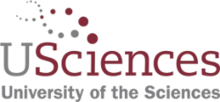Philadelphia College of Pharmacy and Science
 |
|
| Motto | Nosse haec omnia salus est ("To know all this is health") |
|---|---|
| Type | Private |
| Established | 1821 |
| Endowment | approx. $170 million |
| President | Paul Katz, MD |
|
Academic staff
|
190 |
| Undergraduates | 2,246 |
| Postgraduates | 418 |
| Location | Philadelphia, Pennsylvania, United States |
| Campus | Urban |
| Athletics | 12 varsity teams, 17 intramural clubs |
| Colors | Maroon and Gray |
| Mascot | Devils, "Drake the Devil" |
| Affiliations | Division II NCAA, CACC, ECAC |
| Website | www |
The University of the Sciences (USciences), officially known as the University of the Sciences in Philadelphia, is a university in the Spruce Hill neighborhood of Philadelphia. USciences offers bachelor's, master's, and doctoral degrees in pharmacy and a variety of other health-related disciplines.
The history of the University of the Sciences began when 68 Philadelphia apothecaries met in Carpenters' Hall in 1821 to establish improved scientific standards and to train more competent apprentices and students. They sought to enhance their vocation, as well as protect public welfare. Nearly a year later, they organized and incorporated the Philadelphia College of Pharmacy (PCP), the first college of pharmacy in the nation. Thus, education in the profession of pharmacy in the U.S. was born.
Today, the University continues to build on that reputation and is now home to over 30 degree-granting programs in four colleges. Its nearly 2,700 students have enrolled in premier programs in the health sciences, ranging across pharmacy with its direct entry doctoral program to pre-med to physical therapy to healthcare business and health policy. Students study almost the entire range of the health sciences in one of its four colleges:
After its conception in 1821, the college began to grow in enrollment, curriculum, and stature. Although matriculation was originally limited to men, the college became coeducational in 1876, and issued the first pharmacy degree to a woman in the United States, Dr. Susan Hayhurst, in 1883. The college initially emphasized the biological and chemical sciences as mainstays of the curriculum in pharmacy but later instituted separate curricula in three other areas: bacteriology, biology, and chemistry.
In 1921, the name of the institution was changed to Philadelphia College of Pharmacy and Science, with state authorization to grant not only the baccalaureate degree, but also the master’s and doctorate in all four disciplines.
As the world of science continuously made advancements throughout the decades, the college evolved and expanded its curriculum to prepare students for the new wave of scientific breakthroughs. The college also enhanced the role of the humanities and social sciences in its science-based curricula. Primarily a commuter campus in its early days, the institution began to transform into one in which residential life and extracurricular activities played a larger role in student development.
The Commonwealth of Pennsylvania approved the institution’s application for university status in February 1997. In recognition of the broad spectrum of new health and science programs introduced by the institution, the college changed its name to reflect the broader range of academic opportunities offered to its students. On July 1, 1998, Philadelphia College of Pharmacy and Science officially unveiled its new identity as University of the Sciences in Philadelphia.
...
Wikipedia
